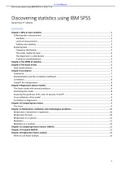Summary
Summary of most important points of book "Discovering statistics using IBM SPSS"
- Course
- Institution
- Book
Dit is een samenvatting van het boek "Discovering statistics using IBM SPSS" door Andy Field 5e editie . Uitgever: Sage. ISBN 9521 Samenvatting bevat hoofdstukken van 1,2,6,8,9,10,11,12,14,18 De taal van deze samenvatting is Engels.
[Show more]




